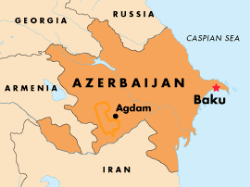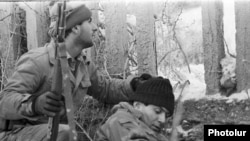Meanwhile, the Karabakh Armenian leadership has rejected one point on which Armenia and Azerbaijan have reportedly reached agreement, namely holding a referendum on the future political status of the unrecognized Nagorno-Karabakh Republic (NKR). The Karabakh Armenians have further signaled their reluctance to cede all the Azerbaijani districts they currently occupy before a firm agreement is reached on the future status of the NKR.
Confidentiality Broken
Over the 14 years that the Minsk Group has been trying to mediate a political solution to the Karabakh conflict, those involved have generally abided by a "gentlemen's agreement" that the negotiating process should remain confidential.
The rationale for doing so is primarily to avoid derailing the peace process by alerting the public in one or other country to unpalatable concessions required that opposition parties might seize upon to discredit national leaders prepared to accept those concessions.
But the co-chairs, who have on several previous occasions deplored the failure of the Armenian and Azerbaijani presidents to prepare public opinion for inevitable concessions, seem to have concluded that going public may encourage the two presidents to demonstrate what they term "the necessary political courage" and agree at least to the basic principles of a settlement before the perceived window of opportunity for doing so closes with the approach of parliamentary elections in Armenia in May 2007.
The basic principles, as outlined in a statement by the co-chairs on June 22 to the OSCE's Permanent Council in Vienna and posted on June 28 on the website of the U.S. Embassy in Yerevan, point to a "phased-package" approach to resolving the conflict, meaning that the various elements of a settlement are agreed on simultaneously, even though they are implemented successively, with one key aspect -- the final status of the NKR -- to be decided by "a referendum or vote" at some unspecified future date.
"These principles include the phased redeployment of Armenian troops from Azerbaijani territories around Nagorno-Karabakh, with special modalities for Kelbacar and Lachin districts [separating Karabakh from Armenia proper]," said the co-chairs. "Demilitarization of those territories would follow. A referendum or population vote would be agreed, at an unspecified future date, to determine the final legal status of Nagorno-Karabakh."
"An international peacekeeping force would be deployed," added the statement. "A joint commission would be agreed to implement the agreement. International financial assistance would be made available for demining, reconstruction, resettlement of internally displaced persons in the formerly occupied territories and the war-affected regions of Nagorno-Karabakh. The sides would renounce the use or threat of use of force, and international and bilateral security guarantees and assurances would be put in place."
Those provisions correspond very largely to the ones contained in the draft peace settlement proposed by the Minsk Group in May-July 1997, the key difference being that the 1997 document contained no specific mention of Kelbacar.
Practice Makes Perfect
The mediators said the conflicting parties would also have to work out practical modalities of the Karabakh referendum. "Suitable preconditions for such a vote would have to be achieved so that the vote would take place in a noncoercive environment in which well-informed citizens have had ample opportunity to consider their positions after a vigorous debate in the public arena."
In a statement released on June 26, the Armenian Foreign Ministry highlighted what it said were further key details and omissions. It noted that the co-chairs' statement did not note the need to grant the NKR "intermediate status," presumably meaning that it would be under international control, until the holding of the referendum on its final status. A further "gray area" not touched upon in the Armenian Foreign Ministry statement is the future status of several districts that prior to 1988 were part of the then Nagorno-Karabakh Autonomous Oblast, but which Azerbaijan took control of in May-June 1991, expelling the Armenian population.
The Armenian statement stressed that the co-chairs, for the first time, have affirmed their support for the idea, first floated in December 2004 by NATO Parliamentary Assembly President Pierre Lellouche and former Spanish Foreign Minister Ana Palacio, of a referendum on Karabakh's status, and that the Armenian and Azerbaijani presidents have agreed on doing so.
It further said that at the recent meeting in Bucharest on June 4-5 between Armenian President Robert Kocharian and his Azerbaijani counterpart Ilham Aliyev, the Azerbaijani side rejected an unspecified suggestion by the co-chairs as to how that remaining area of disagreement could be resolved. By contrast, the co-chairs' statement avoided allocating blame for the failure to reach an agreement, saying only that "the two presidents failed to agree."
Speaking to journalists in Yerevan on June 29, Armenian Foreign Minister Vartan Oskanian described the "principles" under discussion as "all-encompassing," in that they cover all the principles affecting the removal of the military consequences of the conflict. He added that "only after full agreement on all these basic principles will the parties begin work on elaborating an agreement on the settlement of the conflict. In other words, the agreement on principles will be comprehensive. The final agreement may envision implementation over time."
Corridor Of Uncertainty
Asked to clarify the co-chairs' reference to "special modalities" for Lachin and Kelbacar, Oskanian explained that the negotiating text specifies that "there will be a [Lachin] corridor linking Nagorno-Karabakh to Armenia." He added that Armenia will insist that that corridor "has the same status" as Karabakh. Oskanian also explained that due to security considerations, "Kelbacar can be returned only after the referendum is conducted and the final status of Nagorno-Karabakh is determined."
He said this is the point of disagreement between the two sides to which the co-chairs referred in their statement to the OSCE Permanent Council last week. Oskanian said that the "principles" stipulate that the vote on Karabakh's status will take place among the population of Nagorno-Karabakh. Some Armenian opposition politicians have expressed concern that the entire population of Azerbaijan would participate in the referendum and vote against Karabakh's independence.
Asked the Armenian leadership's overall assessment of the "principles," Oskanian said "this is not a perfect document. For anyone. However, there are enough solid and balanced provisions, with the right trade-offs on the main issues -- status, territories, and security -- that we are prepared to continue to negotiate on the basis of these principles," Noyan Tapan reported.
But the Karabakh Armenians, who to their frustration are excluded from the Armenian-Azerbaijani talks under the Minsk Group aegis, are unhappy with at least two of the provisions of the "basic principles." Even before this week's disclosures, the NKR posted a statement on its website on June 12 citing the arguments against determining the republic's future status in a referendum. The article reasoned that holding a further referendum would call into question the legality of the referendum of December 10, 1991 in which the overwhelming majority of the region's Armenian voters opted for independence from Azerbaijan. It noted that most Azerbaijani voters declined to participate in that plebiscite.
Return To The Front
And on June 26, Vahram Atanesian, who is chairman of the NKR parliament standing committee on foreign relations, was quoted as rejecting the "principles" as outlined by the Minsk Group co-chairs on the grounds that they entail the "unequivocal return" of the occupied territories -- the NKR's sole bargaining chip -- in return for a decision at some unspecified future date on the republic's status. Atanesian said his perception is that the Minsk Group is pressuring Armenia to accept proposals that "are fully consistent with Azerbaijan's interests."
Insofar as Azerbaijan has not definitively rejected the current "principles," the present situation is reminiscent of that in the summer of 1997, when Armenia accepted, albeit with reservations, the modified Minsk Group package proposal, while Azerbaijan wavered, and Stepanakert rejected it outright.
The biweekly independent Armenian paper "Iravunk" on June 27 drew the comparison between the current principles and the 1997 plan, but went on to make the point that unlike his predecessor Levon Ter-Petrossian, President Robert Kocharian would never risk publicly making a case for mutual compromise with Azerbaijan. Instead, the paper suggested, Kocharian left it to the Minsk Group co-chairs to do so.
Nagorno-Karabakh
 Click on the map to see an enlarged map of the Nagorno-Karabakh conflict area.
Click on the map to see an enlarged map of the Nagorno-Karabakh conflict area.
In February 1988, the local assembly in Stepanakert, the local capital of the Azerbaijani region of NAGORNO-KARABAKH, passed a resolution calling for unification of the predominantly ethnic-Armenian region with Armenia. There were reports of violence against local Azeris, followed by attacks against Armenians in the Azerbaijani city of Sumgait. In 1991-92, Azerbaijani forces occupied most of Nagorno-Karabakh, but the Armenians counterattacked and by 1993-94 had seized almost all of the region, as well as vast areas around it. About 600,000 Azeris were displaced and as many as 25,000 people were killed before a Russian-brokered cease-fire was imposed in May 1994.
For a complete archive of RFE/RL's coverage of the Nagorno-Karabakh conflict,click here.
Of particular interest:
2005 In Review: Conflicts In Caucasus Still Characterized By Gridlock



















